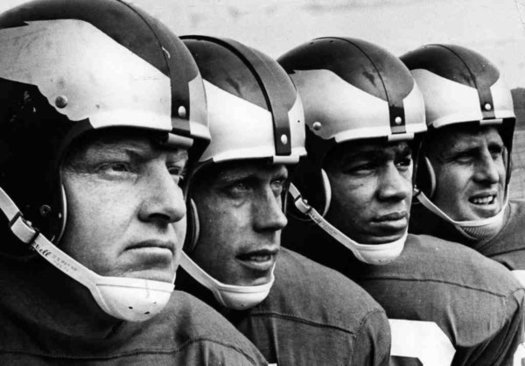
Philadelphia Eagles in 1963. From left: Sonny Jurgensen, Pete Retzlaff, Timmy Brown, and Tommy McDonald. Photo via philly.com.
Like a gazillion or so fans, semi-fans, and just curious non-fans, I watched the recent Superbowl, even though my hometown Forty Niners had not made it to the Big Show. And I stayed with it even though it was a miserably lopsided game. But despite the fact that I’ve been a fan of football since I played in high school, this Superbowl carried — for me and others — a new and gnawing guilt. The recent revelations of brain damage caused by helmet-to-helmet collisions, and the multi-million dollar settlement between the National Football League and suffering retired players, have begun to make even a long-time fan think of college and professional games as Future Dementia Bowls. And I’m feeling a new hesitation about watching athletes beat the hell out of others and themselves. This was the reason that I stopped watching boxing years ago.
Much hand wringing is now part of the discussion of football consussions, quite a lot of it for show only, the manual equivalent of crocodile tears. But much of the anxiety is genuine, for who wants to see one’s erstwhile heroes forgetting their names, or worse, killing themselves, as at least a few retired NFL players have done when they felt dementia coming on?
As with many problems, design may be part of this worrisome situation. The protective gear worn by players today is better and more protective than the uniforms of my playing days, by many orders of magnitude. The (perhaps) unforeseen consequence of better armor is a far more violent game, with well-shielded bodies converted into guided missiles and helmet-first hits replacing the shoulder tackles of yore. New rules against spearing (the chilling term for helmet tackles) will go some part of the way to easing the concussion epidemic, and better helmets may help — though they may also make players feel safer doing dangerous things. But I have a quick and easy and — I think — instantly effective way to solve the problem: Not more protection, but less.
In short, take away the facemask. No player in the game today has ever played without a cage of metal and vinyl shielding his face, and very few fans or former players have ever seen or played games without this standard piece of equipment. I am one of those few, however, and at the risk of outing myself as an early Cro-magnon, I will note that when I played high school football we had nothing in front of our faces other than giant blockers and fullbacks the size of freight trains (or so it seemed to me, a skinny kid with dreams of impressing the cheerleaders). In the final two years of my otherwise forgettable football career, before switching to lacrosse in college, I and my teammates considered shockingly sissified the first appearances of single, transparent bands of Lucite on the helmets of a few players with expensive orthodontia work. Real men, we figured, did not worry about the chance of a broken nose or a few lost teeth. But of course we did worry, perhaps wrongly imagining that our faces were our fortunes. So nobody ever dove into a tackle head first. Instead, we were taught to tackle with our shoulder pads, and practiced the technique for hours on tackling dummies. Our helmets were far from the state of today’s art, but I don’t remember more than a few, very rare concussions. Better yet, I can still remember almost everything else about those days…a good sign, I think.
If high school, college and professional football teams could forge a kind of anti-missile treaty, facemasks could be gone by the start of spring training. Mouthpieces can do a pretty good job of protecting players’ teeth, and a return to shoulder tackling will keep noses unbroken. And, of course, there will be no more of those penalties for those nasty facemask takedowns.
So…anyone for some barefaced ball?


Comments [3]
02.14.14
05:05
02.14.14
10:10
02.14.14
11:07